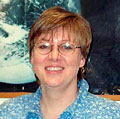 |
|
|
| Author |
Message |
Patty_Cie

Joined: 23 Mar 2004
Posts: 87

|
 Posted:
Sun May 23, 2004 5:53 pm Posted:
Sun May 23, 2004 5:53 pm |
  |
May 21, 2004 Friday
7:30 PM Alaska time
We got to station 7 last night about 9:30 PM. It took a while to find
the right conditions to begin sampling. There needed to be a good ice
flow on one side of the ship for the teams who go off the ship and
sample the ice and open water on the other side of the ship so the water
and organism sampling equipment (CTD package, plankton nets, van Veen
grabs, etc.) could be put into and taken out of the water undamaged.

The MST (Marine Science Technician) Coast Guard personnel create open water for the science equipment by using long poles to move chunks of ice away from the Healy.
It was close to 2:45 AM when it became our turn to collect water. A
chlorophyll trace showed the water column had uniform levels of
chlorophyll so we sampled only at the 10 m depth. We filtered 150 ml
for each of the four replicas at this station. It was 4:15 AM when the
last sample was completed. At 4:30 AM Susan Schonberg, University of
Texas Marine Science Institute, and I went to bed leaving Craig Aumack,
University of Texas Marine Science Institute, sorting zooplankton
samples. When we got to our room, we could see Rolf Gradinger’s group
out on the ice through the port hole.
I was back in the lab at 8:30 AM and found Susan sorting zooplankton
samples. She let me help. I picked out arrow worms from a Petri dish.
Arrow worms have clear, long bodies and are easy to spot in the sample.
I also sorted one genus of copepod, Pseudocalanus. Pseudocalanus are
small and have a bit of pink/red color. It takes about 300
Pseudocalanus bodies to make one isotope sample. We collected two
replicas of arrow worms and Pseudocalanus. We try to get four replicas
to ensure data accuracy, but there were not enough animals in today’s
sample.

A Petri dish filled with a zooplankton sample. The arrow worms can be seen in the sample. They look like whitish long threads. The golden green color is phytoplankton.

Ms. Cie sorting Pseudocalanus. Notice the nice bedhead.
At 11:00 AM I helped Susan collect the benthic sample. Everyone on deck
during sampling must wear a mustang suit and a hardhat for safety.

van Veen grab ready to go overboard.

van Veen grab going into the water.

van Veen grab coming out of the water.

Jackie Grebmeier, Chief Scientist, University of Tennessee, opening van Veen grab over a galvanized collection bucket.

Arianne Balsom, University of Tennessee, taking a sediment sample from van Veen grab.

Lee Cooper, University of Tennessee, transfers the grab sample from the galvanized collection bucket to a wooden sieve box. The box is lined with wire mesh which allows the mud and water to leave the box, but keeps the animals inside.

Animals found in the grab sample. After the mud is washed away, the animals will be transferred to the lab for sorting and drying. The tubes are made by tubeworms.
At 5:15 PM I saw my first polar bear. I was so excited. I always think
about polar bears being white, but against the snow and ice the bear
appeared to be a cream color. The black nose and pads were easy to see.
I saw the bear put its nose into the snow. I think it was looking for
food, but I would like to ask a bear biologist if the behavior had any
other meaning. When the bear would walk/run away, it had a great
lumbering motion. I was able to get some video of the movement and will
try to add a small movie clip when I return to shore.

My first look at a polar bear in the wild.

I saw the polar bear put its nose into the snow.
To see photographs taken by Steve Roberts of UCAR/JOSS, click here. |
|
|
    |
 |
|
|
|
View next topic
View previous topic
You cannot post new topics in this forum
You cannot reply to topics in this forum
You cannot edit your posts in this forum
You cannot delete your posts in this forum
You cannot vote in polls in this forum
You cannot attach files in this forum
You can download files in this forum
|
Powered by phpBB 2.0.11
© 2001, 2002 phpBB Group :: FI Theme ::
All times are GMT
| |
